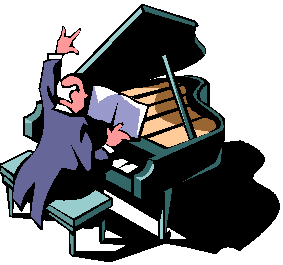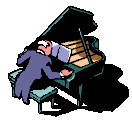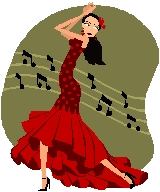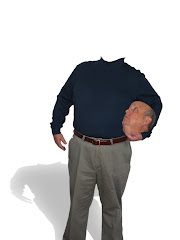Sunday, September 14, 2008
What is a Piano Concerto?
A piano concerto is a type of classical composition that features the piano accompanied by a group of instruments used to produce a full backing sound. The instrument group in a piano concerto is usually an orchestra (though smaller ensembles aren't at all uncommon), and the piano concerto is almost always written in sonata form. The best known examples of the piano concert are from the baroque and classical eras when Bach and Mozart, respectively, specialized in the form; it's important to note, however, that Bach's piano concertos were adapted to the piano only after the harpsichord fell out of favor.
Many, many piano performances are comprised of a piano concerto; it's a wonderfully melodic, magnetic form of composition made even more compelling by the orchestral accompaniment. But even though the orchestra is much larger than a singular pianist, the piano is truly the star of a piano concerto. The orchestra's music is composed carefully to showcase the instrument and makes the piano sound fuller and richer as a result.
As the piano concerto is written in sonata form, the piece usually contains three movements -- though these will often shift and change to reflect less of the sonata form on which they were based. The first movement of a piano concerto is the shortest part; it's upbeat and energetic, grabbing the listener with the first note. The second movement of a piano concerto is far slower, often with the orchestra dropping back to give the piano's melodies a fair amount of space. The last movement of a piano concerto returns to a dynamic similar to that of the first movement, sometimes larger; at times the third movement will re-introduce the original melody of the piano concerto, but it is by no means rote for the form.
Saturday, September 13, 2008
What Are "Piano Tabs?"
 Piano tabs, strictly speaking, are a form of sheet music that notates the music by showing where the fingers are to be placed instead of the notes themselves; the form is also known as tablature and is frequently used for guitar, as well. Technically, there is no such thing as piano tab. Tablature, though vast in its capabilities, is only intended for fretted string instruments, and while piano is certainly a string instrument, it isn't fretted. The term piano tab is actually used to refer to fingering charts (charts often used in instruction to aid in the correct placement of the fingers on the keys) or, most commonly, traditional sheet music.
Piano tabs, strictly speaking, are a form of sheet music that notates the music by showing where the fingers are to be placed instead of the notes themselves; the form is also known as tablature and is frequently used for guitar, as well. Technically, there is no such thing as piano tab. Tablature, though vast in its capabilities, is only intended for fretted string instruments, and while piano is certainly a string instrument, it isn't fretted. The term piano tab is actually used to refer to fingering charts (charts often used in instruction to aid in the correct placement of the fingers on the keys) or, most commonly, traditional sheet music. Piano tab in terms of traditional sheet music is the written notation for a piece of music. It tells that musician what to play, for how long and in what sort of manner. Notes are dictated via a series of ovals, often stemmed, on a musical staff consisting of five lines and four spaces. Where the notes are located vertically on the staff indicates what pitch is to be played, and the note's physical appearance in the piano tab indicates its duration. Piano tab also includes other specifications like time signature (the song's meter), key signature (the key in which the song is played) and tempo (the speed at which the song is played).
Not all piano tab indicates the same things, however. Some piano tab, especially that found in jazz ensembles and popular music groups, is very limited, notating only the bare essentials of chord progression and tempo. In this case, piano tab is really just a quick reminder of what needs to be played; it certainly isn't relied on for the detailed nuance of the song. And some piano tab, often referred to as a score, is extremely detailed, including not only the piano parts, but the parts of every other instrument as well. This type of piano tab is intended mostly for conductors, though sometimes pianists use condensed versions as a guide to the overall melody.
Friday, September 12, 2008
Songwriting & Chord Progressions
 At the very cornerstone of songwriting are chord progressions. They are, simply, chords played in sequential order. But chord progressions aren't as easy as just knocking out a few chords in a row. Chord progressions must somehow be tied together; in order to be a true chord progression, the chords must feel like a whole. Creating this entire entity can be achieved in a number of ways; a songwriter may link chords based by proximity or by common notes. Chord progressions might even be based on how absolutely different the chords are, it really doesn't matter. It's all based on the style and taste of an individual songwriter; the best songwriters can make strange, seemingly unrelated chords into viable chord progressions.
At the very cornerstone of songwriting are chord progressions. They are, simply, chords played in sequential order. But chord progressions aren't as easy as just knocking out a few chords in a row. Chord progressions must somehow be tied together; in order to be a true chord progression, the chords must feel like a whole. Creating this entire entity can be achieved in a number of ways; a songwriter may link chords based by proximity or by common notes. Chord progressions might even be based on how absolutely different the chords are, it really doesn't matter. It's all based on the style and taste of an individual songwriter; the best songwriters can make strange, seemingly unrelated chords into viable chord progressions.Chord progressions are based on a series of chord changes, and these changes form the basis for the melody to be formed. Chord progressions are the harmonic backbone of a song, and they often dictate the song's tone and mood. Modern music tends to frequently base chord progressions out of the first, fourth, and fifth degrees of the scale; in C major, this would be C, F, and G. Of course, these chord progressions can be varied in a number of ways (chord substitution allows heavily for that), but these basic chord progressions tend to be the framework for a decent portion of modern music -- especially rock and pop.
There are no specific rules governing chord progressions, but modern rock and pop music seems to thrive on the most minimal amount. The early days of both rock and punk music were full of songs with only three chords in the chord progressions and only a few minor substitutions. Because punk music was the province of those shunning an overwhelming knowledge of music theory, these simple chord progressions could have been the result of an inability to play much else. But simple chord progressions survived that period and moved through to musicians who have been classically trained; this has everything to do with the catchiness of simple chord progressions. A three or four chord progression gives freedom for the melodies to be explored to far degrees and allows the listener to remember the chord progressions very easily. If the chord progressions are memorable, they tend to be repeated over and over again, creating a unmistakable catchiness. And that catchiness is what has made simple chord progressions the most desirable form in modern rock and pop.
Thursday, September 11, 2008
Music Notes & How They Work
Notes are the musical notation representing a fixed pitch. While the word strictly refers to the physical notation of a pitch, it's more commonly used to refer to both the pitch and the notation. When we're trying to figure out a piece of music, we rarely ask which pitches are being played; we always ask which notes are being played. But if we try to describe a song as having the same note in several places, we're technically wrong. Considering that each note is a separate notation, even if the pitch is the same, it's impossible to have the same note in several places.
Notes are named after the first seven letters in the alphabet -- A, B, C, D, E, F, and G -- and keep the same letter value regardless of the octave. But since there are twelve notes in a diatonic scale, the seven notes can be altered. To get the extra five notes, we sharp (raise by a half-step) and flat (lower by a half-step).
The types of notes and their values are based on the amount of time they take up in a song.
Whole notes (or breve notes) are four beats, which is equal to one measure in 4/4 time. They are represented by a hollow, oval note with no stem.
Half notes (or minim notes) are half of a whole note, or two beats. They are written as a hollow note with a stem that points up when placed below the middle of the staff, up when placed above it.
Quarter notes (or crochet notes) represent a quarter of a whole note, or one beat in 4/4 time. They are the most recognizable note: a solid black note with a stem.
Eighth notes (or quaver notes) are one-eighth of a whole note and are written exactly like a quarter note, but with a flag attached to the stem. When more than one eighth note is placed side by side, a solid beam connects the adjacent notes.
Sixteenth notes (or demiquaver notes) are one-sixteenth of a whole note and represented as an eighth note with two flags or two solid beams.
Thirty-second and sixty-fourth notes represent the section of a whole note indicated by their names; they are drawn as eighth or sixteenth notes with an additional flags.
It's also important to mention that a note's value can be changed by adding a dot. Dotted notes represent the value of the original note, plus one half. For instance, dotted half notes are held for three beats, dotted quarter notes for a beat and one half, and so on.
Wednesday, September 10, 2008
Are Guitar Chords Different Than Piano Chords?
More than one person has asked me this question: "What's the difference between piano chords and guitar chords?"
 The answer is: none. But that doesn't mean a piano player could go to the guitar an automatically know where a given chord is found -- a fretboard is laid out differently than a keyboard. And the tone quality is certainly different. But as for the chords themselves, there is no difference.
The answer is: none. But that doesn't mean a piano player could go to the guitar an automatically know where a given chord is found -- a fretboard is laid out differently than a keyboard. And the tone quality is certainly different. But as for the chords themselves, there is no difference.Guitar chords, chords played specifically on a guitar, differ only from other types of chords by virtue of instrument; they're simply a series of three or more notes played together. These notes don't necessarily have to be played simultaneously, however. Broken chords (also referred to as arpeggios) are three or more notes that aren't played at the same time but closely enough to still be heard as a group or whole. And even the three-note rule is open to the occasional exception; some guitar chords consist of only two notes, but they still function as chords because they work diatonically in the same way that a major or minor chord would.
Guitar chords might very well be the most important element of guitar playing; after all, they're the basis of what makes a song. Most people picking up a guitar for the first time figure out a few guitar chords before even going for their first lesson, and still more teach themselves guitar chords without any help from an instructor. Self-taught guitarists learn guitar chords in a number of ways. Some learn by listening to their favorite songs and slowly picking out the notes, a common yet often frustrating process. Others figure out guitar chords by learning to read guitar tab, a type of sheet music intended for fretted instruments that uses a graph-like chart to show where on the frets the fingers are placed. Both techniques are common among those learning guitar chords, though the number of self-taught guitarists who never learned to read tab is fairly high.
Just like any other instrument, the sheer number of possible guitar chords can often be overwhelming for a new guitarist. And even the frequently taught guitar chords are beginning to fall by the wayside, making room for a variety of guitar chords created by tuning the strings in almost innumerous ways. Though power chords (guitar chords using a base note, an octave note and the fifth) are still the most common type of guitar chords, new bands are increasingly experimenting with alternate tunings to create new sounds; alternative bands such as Sonic Youth have been toying with this way of playing interesting guitar chords for decades.
Tuesday, September 09, 2008
Songwriters Who Sing Their Own Songs
The singer-songwriter is a modern popular music phenomenon. The term's meaning is fairly implicit; a singer-songwriter is a musician who not only performs but also writes the music that they are performing. Though the act of writing your own material is somewhat par for the course in modern popular, rock and country music, the term evolved in a time when singers and performers, not songwriters, ruled the day. As the presence of performers who composed their songs became more and more common, the term singer-songwriter switched to refer to a specific style of music, one that is often associated with folk or country traditions.
Though a Latin tradition had started years before, the American singer-songwriter appeared in the late 60s and early 70s. It was a style bred out of necessity in a tumultuous time; songwriters typically shied away from writing about touchy, political topics, and the many folk artists, including Carole King, Bob Dylan and James Taylor, felt the need for an alternate view to be expressed. Additionally, these singer-songwriter artists (many of whom had been writing for other musicians) desperately wanted to perform their own material instead of handing it over to someone else destined for its glory. It took awhile, but record labels eventually latched on to the singer-songwriter influx, understanding its impact on both the public and the industry.
As time passed and the war ended, the folksy singer-songwriter tradition seemed to slow considerably, but the mark had been made; artists attracted to the singer-songwriter trend began writing and performing their music, forcing self-composition into the limelight as an industry standard. And even though nearly every rock band could be considered a group built of the singer-songwriter, the term stayed firmly rooted within the folk tradition; the label itself didn't re-emerge until the mid-90s, when a wave of female singer-songwriter artists such as Indigo Girls, Sarah McLachlan and Suzanne Vega revived the original form. It has since branched slightly out of the folk scene, encompassing such rock-influenced singer-songwriter artists as Bright Eyes and Dashboard Confessional.
Monday, September 08, 2008
Songwriting Is More Than Writing a Song
Songwriting is, in it's most basic definition, the act of writing a song (obviously).
But the word doesn't even have to apply to that specifically; the term songwriting is often used to describe the writing of individual song parts, such as the guitar or vocal melodies. Strictly speaking, songwriting and composing are interchangeable words. They do, after all, denote the exact same thing. But the connotation here is radically different. While composing is seen as the province of classical musicians who actually record their compositions onto sheet music, songwriting is far more informal, the work of rock, pop, folk or country musicians who may take some notes, but generally commit everything they've written to memory.
The actual act of songwriting varies from musician to musician. Some say that solo musicians have the easiest time of songwriting, writing whatever they want without having to clear it with a band or partner. But solo musicians also carry the burden of songwriting wholly on themselves. When they lack inspiration for a certain part or harmony, they don't necessarily have someone to fix the songwriting block for them. Musicians songwriting as part of a group, however, are given the luxury of using their band-mates as a sounding board.
In many band situations, no one person is responsible for all the material; someone will write a part, which is then elaborated on by the others. For instance, a guitarist may come to band rehearsal with a solid verse and chorus. The drummer may then write a series of parts based on the guitarist's part, the bass will write based on the drums, and keyboards or other instruments will write based on that core grouping. Vocal melodies are frequently the province of the vocalist alone, and while every musician has some say in what the other musicians are playing, the songwriting from instrument to instrument is largely the decision of the individual musicians. There are no strict rules to songwriting; whatever works for the musicians in question becomes the norm.
Saturday, September 06, 2008
Mp3’s – The Future of Music?
Mp3 music is audio that has been digitally encoded and compressed to make the amount of data smaller without compromising the overall sound quality. It's a revolutionary technique with incredibly good results; mp3 music is frequently indistinguishable from music found on a CD (though some audiophiles with very sensitive ears dispute that statement). The popularity of mp3 music made available on the Internet is a trend reaching gigantic proportions; these encoded songs are everywhere. Websites called mp3 blogs offer rare or hard-to-find mp3 music and avid fans sometimes spend hours at a time sifting through the piles of downloadable material. Newer recording artists that would often fall under the radar without the help of a well-known label are now able to convert their songs into mp3 music and make them available on the Internet, allowing huge numbers of people the chance to hear songs that they otherwise wouldn't have been exposed to. It's an extremely popular thing, mp3 music, one of those rare pop-culture phenomena embraced by nearly everyone.
But regardless of its massive popularity, mp3 music is surrounded with controversy. Many programs that allow users to transfer mp3 music directly from computer to computer offer the services for free, eliminating the possibility of royalties for the artist and label. Fearful of losing tons of money to fans downloading records instead of buying them, large factions of the music industry fought to make free mp3 music illegal -- and succeeded to a degree. The laws, however, have loopholes, and many websites or P2P programs have exploited them for all they're worth. Additionally, laws regulating mp3 music in the United States aren't necessarily applicable to other countries, so new websites and programs (particularly, for some reason, in Russia) have popped up offering the free services railed against in America. Because of the hotly argued ethical issues surrounding mp3 music, many shy away from the topic (and practice) completely. Others embrace it, citing huge record costs as justification enough for free mp3 music. It's an argument not likely to end anytime soon; the ethical issues will be debated as long as free mp3 music is available somewhere.
Friday, September 05, 2008
What exactly is a "rhumba"?
The rhumba is a Cuban style of dance and music with strong African roots; it's very percussive and rhythmic, similar in many ways to a bossa nova. But the modern rhumba, the Americanized rhumba we recognize today, has undergone several radical changes from the African version brought to Cuba via the slave trade. The African rhumba, noted in the 16th century, is highly sexual and aggressive. The music is energetic, fast, staccato; it mimics the aggressiveness found within the dance. The staccato beats are very exaggerated, as exaggerated as the movements that go with them, and the instrumentation is mostly percussion.
The Cuban rhumba, first discovered in the 18th century, is far less aggressive than the African form. It's slightly slower and retains its intimacy without being quite as overtly sexual. The general consensus of the time was that the African rhumba, popular in its own right, was far too raunchy. It embodied a blatant sexuality that many people found to be indecent. The dance itself, however, had so many popular characteristics that to let the form die completely would be almost unthinkable. Instead, the African rhumba was toned down into a more subtle form and given some Latin elements particular to the area.
But that wasn't the last we'd see of the highly sexualized rhumba. Strangely enough, the form was given back some of its aggressiveness upon its arrival to the United States during Prohibition. This was a time when cabarets ruled the day and indecency among these circles (though certainly not in the mainstream) was almost encouraged. The rhumba became a common part of cabaret acts, though it was changed slightly to adapt to the stage. Of course, the cabaret rhumba still wasn't as overtly sexual as the African rhumba, but it fit somewhere neatly in between the African and Cuban versions.
Eventually the cabaret rhumba evolved into the modern rhumba, the ballroom dance still danced and played today. This version of the rhumba was toned way down from the African and cabaret versions (even from the Cuban rhumba) and danced slightly faster than usual. This version of the rhumba focused more on the romantic and intimate than the sexual and quickly became known as the dance of love.
Thursday, September 04, 2008
Music Books Galore!
It's truly astounding, the sheer variety of music books on the market today. They are music books covering every historical and modern composer, both musically and biographically. Whole genres are described in 500 pages or more, musical movements detailed to their very core. Individual popular artists with authorized and unauthorized biographies; musicology; lyrical analysis; how to start a band, join a band, manage a band, destroy a band -- it's all covered in the pages of thousands and thousands of music books. And that doesn't even crack the crème brulee of music books filled with sheet music and theory and various lessons. College bookstores are stacked to the walls with these kinds of music books and elementary schools all over the country rely on the basic forms to teach children the basics of music
Those instructional music books are by far the most common type, though they're usually found in educational bookstores as opposed to your local bookseller's shop (or even one of the virtual book mega-malls). The basis of the lessons in music books vary greatly; that, of course, is beauty of them. Some music books will be filled with solely sheet music; though you'll most frequently see these type of music books for piano, they come intended for nearly every instrument imaginable. Music books of this sort are usually divided into volumes based on skill level and frequently used for individual instrument lessons.
Other types of instructional music books, usually those used in required music classes, will contain a combination of sheet music and other lessons, such as theory and history. For instance, music books used in elementary schools will sometimes have a section based on a particular musical genre, such as American spirituals or rock & roll; this section in the music books will contain a brief history of the genre, the rhythmic or thematic elements of the genre and a short excerpt of sheet music (usually vocal) to be played by the students. These music books function as an early primer for young students, teaching them a wide array of various genres and forms.
For piano books online a good source is Top Piano Books
Subscribe to:
Posts (Atom)









